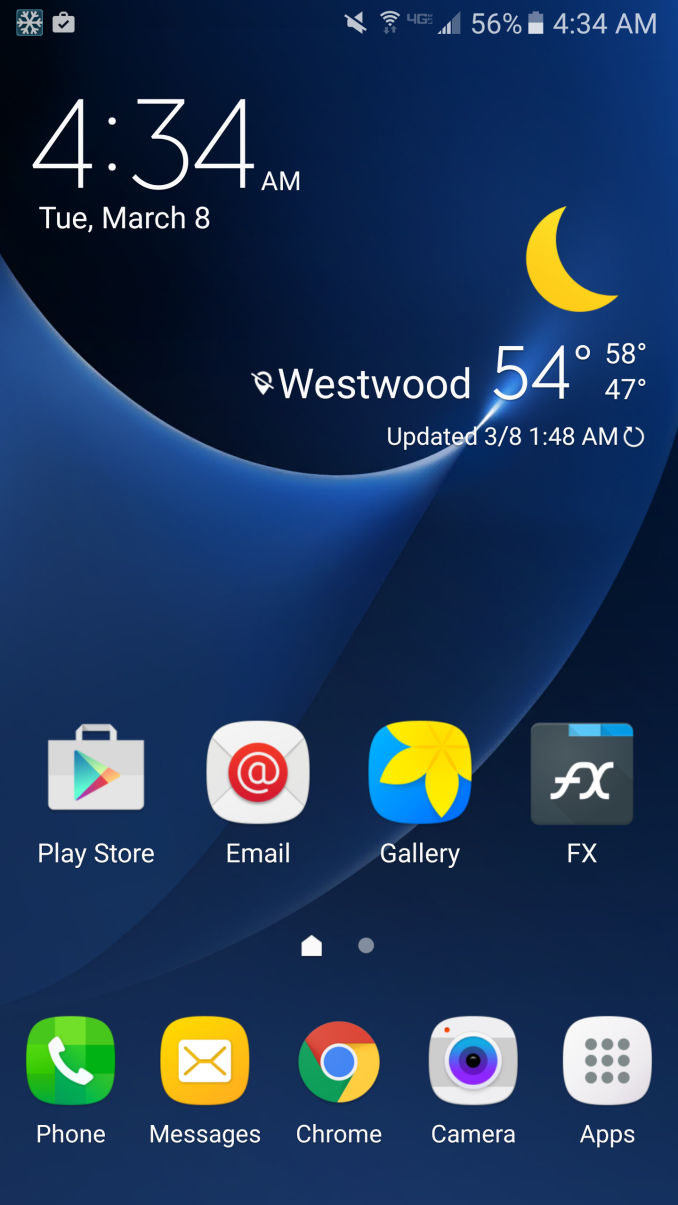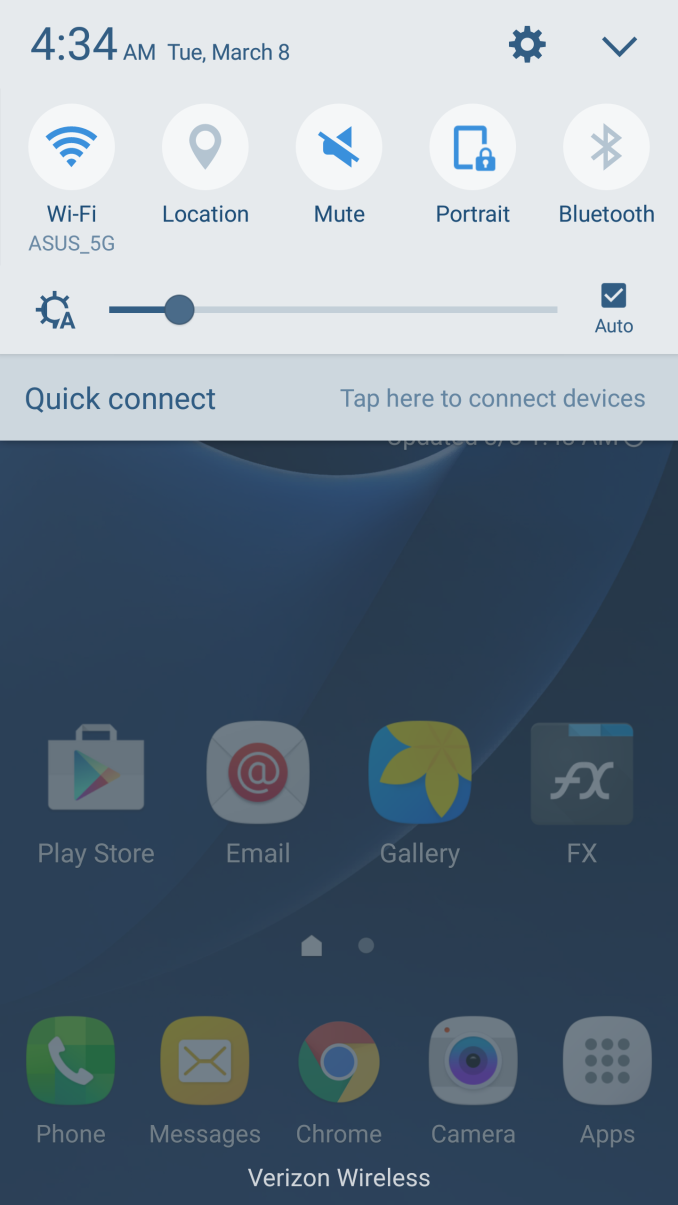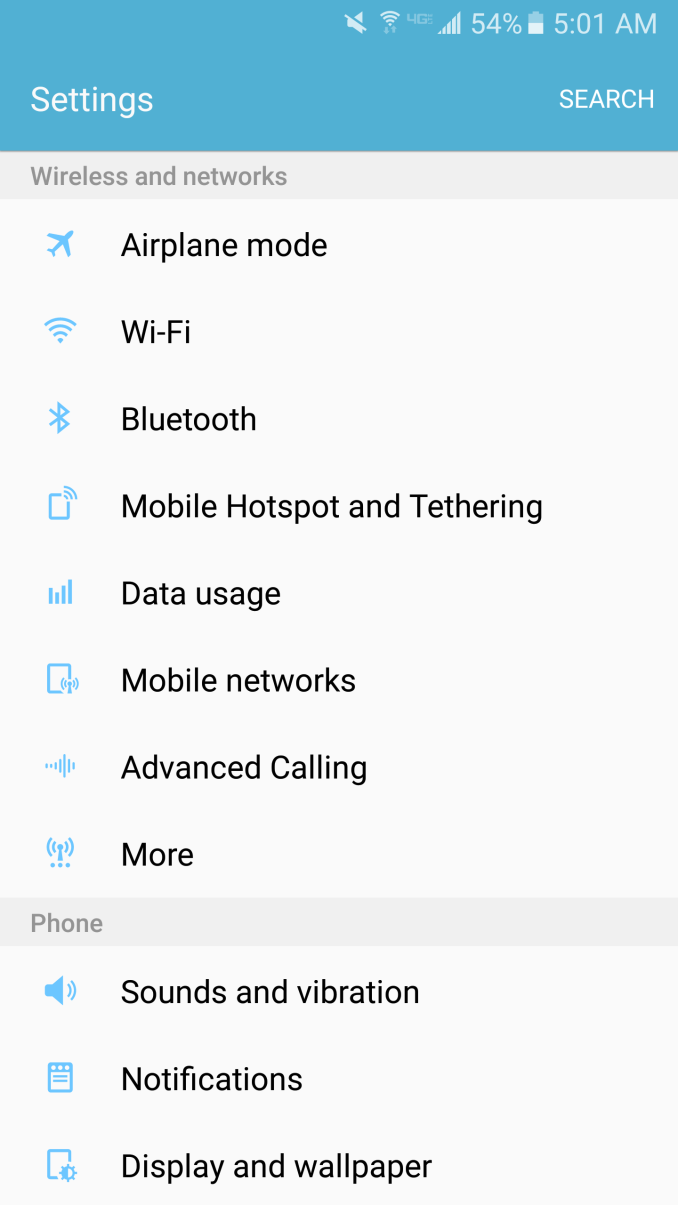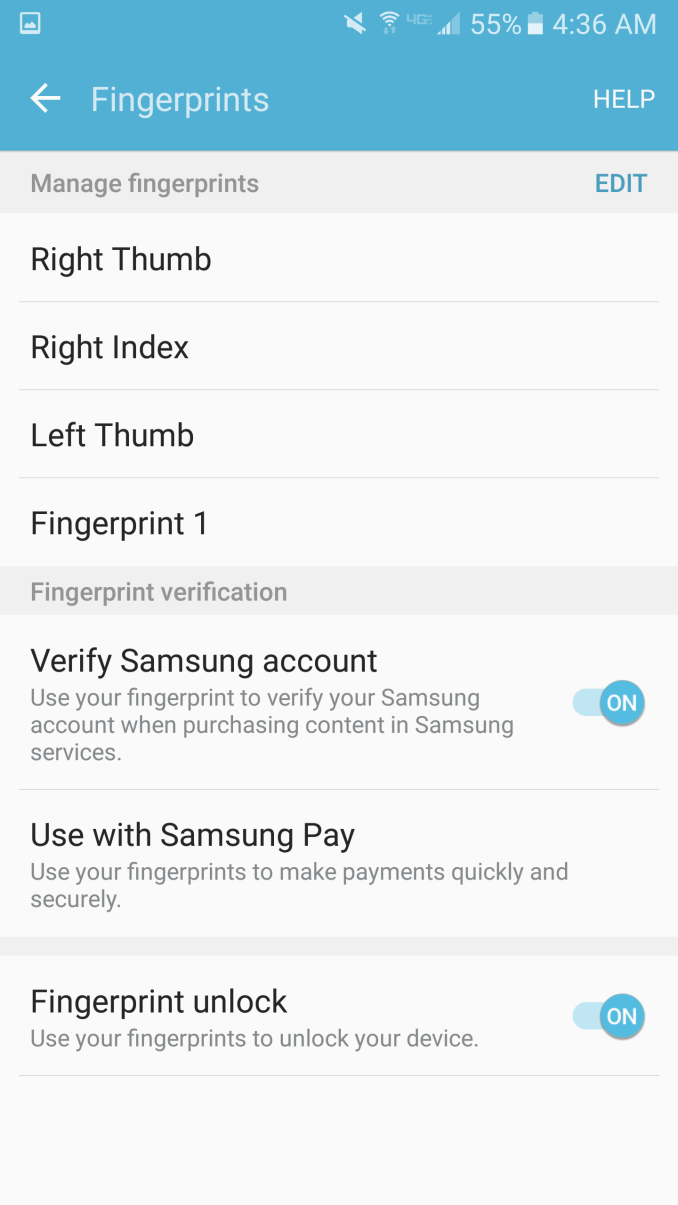The Samsung Galaxy S7 & S7 Edge Review, Part 1
by Joshua Ho on March 8, 2016 9:00 AM ESTSoftware UX
As is always the case, there’s a perpetual debate over the role of the OEM when it comes to Android devices. For better or worse, Samsung seems to believe that they need to add their own framework and UI over Android. To some extent, I suspect that most users are going to find stock Android to be rather spartan out of the box, so it does make sense for OEMs like Samsung to continue adding their own custom applications and frameworks to help differentiate themselves from the competition.
With the Galaxy S5, it was evident that Samsung had dramatically changed their design direction for TouchWiz, but I would argue that their design aesthetic still wasn’t quite perfect, and performance wasn’t completely there either. With the Galaxy S6, Samsung had gotten closer to the mark in some ways, but the continued use of excessively neon colors just made parts of the UI feel off at times, and performance still wasn’t perfect.
With the Galaxy S7, performance has improved noticeably, but it’s really hard for me to say whether this is because Samsung has improved their codebase, or if a faster SoC is just making it harder to notice areas in need of optimization. At any rate, while the Galaxy S7 isn’t perfectly smooth - dropping frames now and then - it is sufficiently performant that you’re not going to find distracting lag.
The default theme of the Galaxy S7 continues to feel pretty similar to the Galaxy S6, so for the most part things are acceptable here, but the use of color is still a bit excessive as a number of icons still use neon colors rather than more neutral pastel colors. Of course, the theme store now has a number of Material Design themes, which greatly improve the situation. I installed one pretty much immediately, which helps make the device feel a lot better in everyday use. However, I’m still of the opinion that this is something that a user shouldn’t need to do out of the box, so this is an area where Samsung can improve.
The other features that Samsung touted for the Galaxy S7 are interesting, but I’m not really sure they’re all that well executed. Always-On Display is nice to have, but for some reason it's quite reluctant to turn off the display when the ambient light sensor and proximity sensor are covered. As a result I turned it off as it’s clearly going to be contributing to idle battery drain in situations where it shouldn’t.
I also found that the fingerprint scanner is pretty much identical to the one in the Galaxy S6, which isn’t entirely surprising as both identify themselves as a Synaptics fingerprint scanner. Both still seem to be quite sensitive to the initial training period and in my experience won’t really work all that well if you don’t cover your entire fingerprint effectively during that period.
Other than this, TouchWiz doesn’t really stand out in any way as of now. Of course, Samsung Pay will be interesting for me to try as I still regularly run into terminals that don’t support NFC in any shape or form, but I haven’t really been able to spend much time testing Samsung Pay yet. I don’t really find TouchWiz to be a bad thing at this point, but I’m not really sure it’s a good thing either. With a serious emphasis on optimization and a major aesthetic overhaul, it’s entirely possible that I could find myself saying quite differently in the near future, but for now if you found the Galaxy S6 and Note 5 OEM UIs to be usable you’ll find the Galaxy S7 to be usable as well.















202 Comments
View All Comments
theduckofdeath - Tuesday, March 8, 2016 - link
I expect them to do a comprehensive test of the Exynos model, as that one seems to be the one they're going to sell everywhere not-USA.NonSequitor - Tuesday, March 8, 2016 - link
Samsung has proven that they can build really great hardware. Great. Now can we go back to getting a GPE version of their phones? I love my Nexus 6's user interface. Every time I try to help a friend with a Samsung phone it feels like the interface has been hit with an ugly stick and all the useful little things have been taken away. But the Nexus 6 hardware is only 'meh', and the 6P isn't better enough to justify a change. If the S7 were a Nexus device I'd be saying TAKE MY MONEY right now.R. Hunt - Tuesday, March 8, 2016 - link
Funny, that's exactly what I think everytime I've got to deal with stock Android: "Where have all the features gone?".Cooe - Thursday, March 24, 2016 - link
Lol what you call "features" I call terrible gimmicks. Stock Android FTW.theduckofdeath - Tuesday, March 8, 2016 - link
No one was interested in the GPE models. Samsung has had no interest in being a Nexus manufacturer for half a decade. That's why. Like it or not, buyers wants the smart features pre-installed at the factory.lopri - Tuesday, March 8, 2016 - link
Throughout the review, Mr. Ho refers to the Note 5 but I do not see any data pertaining to the Note 5 in the charts?I agree with him about the camera hump. I had no issue with the S6's camera hump, both aesthetically and practically. I think this provides an opportunity in which tech media should take a pause and self-reflect. In every freaking review of the S6/Edge, reviewers incessantly cried over that hump as if Samsung committed an unspeakable sin. It looks like Samsung took the criticism to heart, but unfortunately the criticism was an unwarranted one to begin with. Reviewers should think for themselves before following the fellow herd parroting sensational nitpicking on a non-issue.
Ratman6161 - Tuesday, March 8, 2016 - link
The note 5 will perform essentially the same as an S6/S6 edge. I've got a Note 5 and personally I'm not seeing anything in the new generation that would make me lust after an upgrade.R. Hunt - Tuesday, March 8, 2016 - link
Well, at least they address the issue in the right way IMHO: but making a only so slightly thicker phone and taking the opportunity to put a bigger battery in it.ah06 - Tuesday, March 8, 2016 - link
"In the interest of providing another data point and some validation of our testing results, I ran both devices through our old web browsing test to see what the results would be for something that should be display-bound. Here, it’s obvious that the Galaxy S7 edge holds a significant lead over the iPhone 6s Plus"But the actual delta in both cases is exactly the same! 53 mins!
Am I calculating this wrong?
9:58 - 9:05 = 53 mins
14:03 - 13:10 = 53 mins
So the delta in the 2013 and 2016 tests is exactly the same
Andrei Frumusanu - Tuesday, March 8, 2016 - link
Those are decimal hours 9.58h = 9 hours 34 minutes.